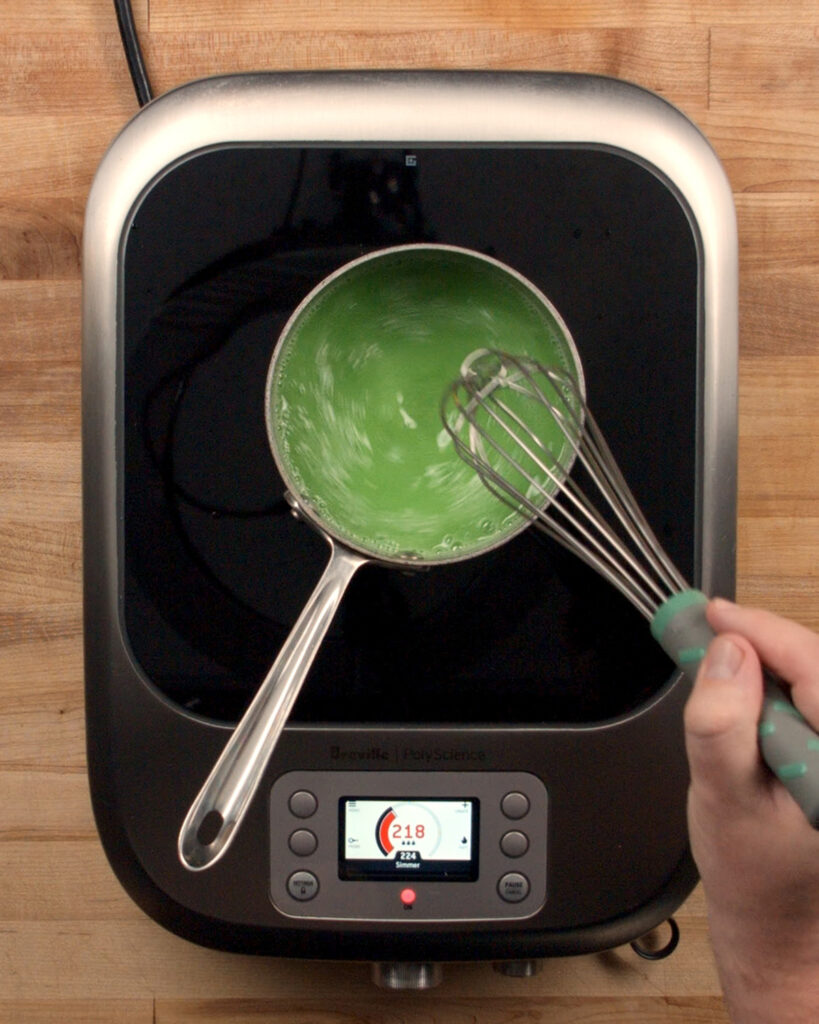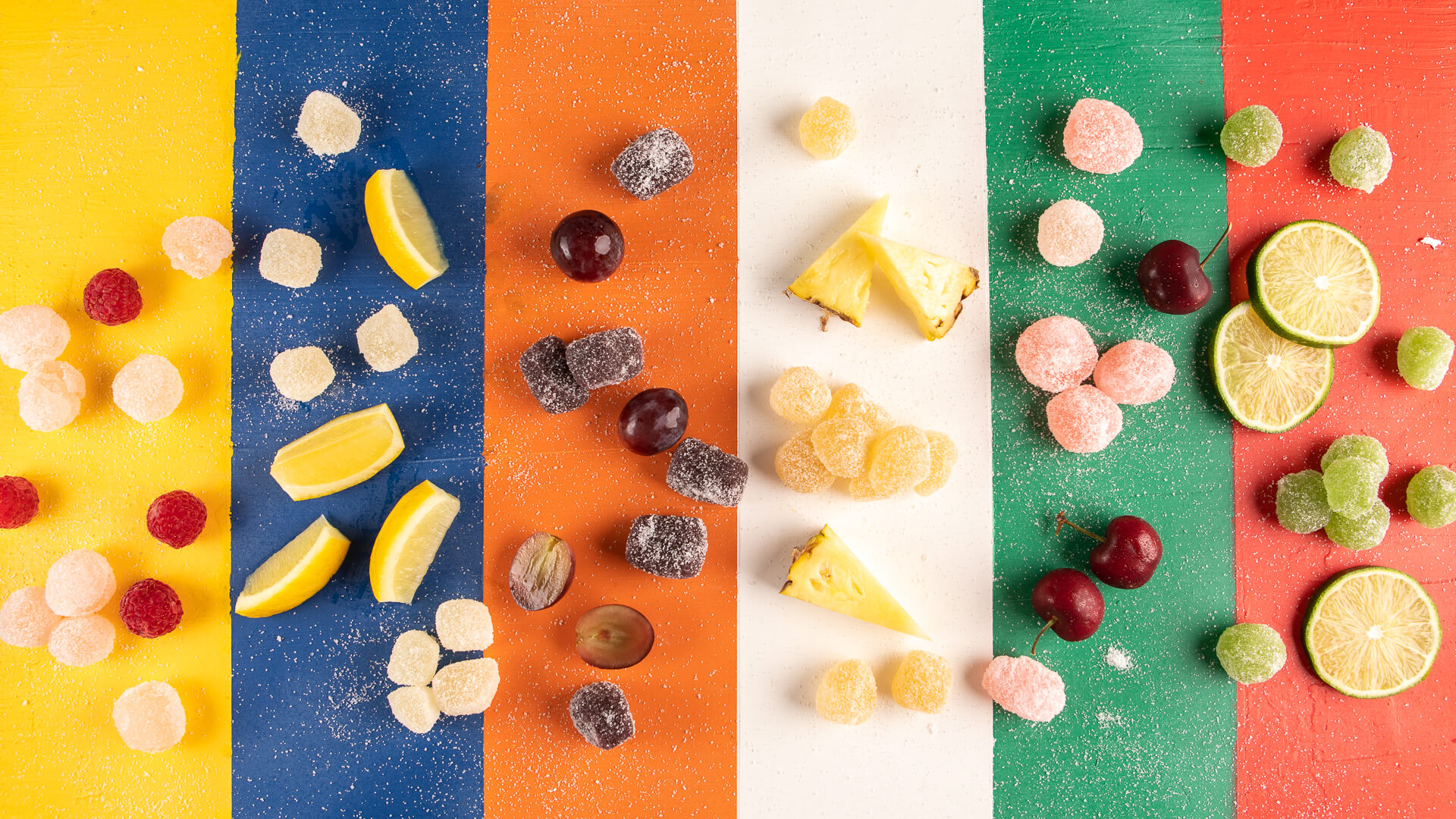What are Pectin Gummies?
Pectin gummies are made with pectin as the main gelling agent. Pectin is derived from the skin of citrus fruits, which makes this gelling agent vegan-friendly. Pectin requires the presence of either sugar or calcium in order to gel, depending on the type of pectin. This course will cover different types of pectin, the ingredients needed to make pectin gummies, and the proper technique for mixing and molding pectin gummies.
Get to Know Pectin
There are two main types of pectin – High Methoxyl (HM) and Low Methoxyl (LM).
HM Pectin is a thermo irreversible gelling agent, meaning once it sets the gel is permanent. It requires a high amount of sugar – 60% dissolvable solids (sugar) and a pH of 3.2-3.3 to gel. HM pectin comes in two varieties – Rapid Set and Slow Set. Rapid Set HM Pectin is the most commonly used type of pectin for home users, and is often used in canning and candy making. Slow set HM pectin will mostly be used in large batch commercial settings. For the purpose of this course when HM Pectin is mentioned we are referring to Rapid Set.
LM Pectin is a type of pectin that only requires calcium content to get. LM pectin is also thermo reversible. This means it can be melted and re-set. It is perfect for low sugar or sugar free applications. LM pectin does tolerate acid but low pH can cause instability with the gel. LM Pectin comes in regular and Amidated. Amidated LM pectin is a type of pectin which only requires very small amounts of calcium to gel. LMA Pectin is used in our sugar free gummy recipe.
Other Ingredients
Sugar
Sugar plays a vital part in the function of pectin. HM Pectin will not gel unless there is 60% dissolvable solids in the recipe. That 60% is most commonly sugar. Sugar of course, also contributes to the relative sweetness of the gummy.
Sugar Alternatives: Isomalt or Glucose DE42
There are two great reasons to use a sugar alternative in conjunction with the sugar in the recipe. I just want to reiterate so that I am perfectly clear this sugar alternative will replace a small portion of the sugar in a recipe. The reason you would do this is simple. Most sugar alternatives are less sweet than granulated sugar. This allows you to get the same texture as you would if you were to use all granulated sugar but you can get a less sweet results.
The second reason you would use a sugar substitute as part of the recipe would be to prevent crystallization. Any recipe that contains a large amount of granulated sugar will most likely crystallize at some point. Sometimes it can crystallize as early as the cooking process. In other cases it will crystallize days after the gummy‘s have been set. Isomalt or glucose DE42 are a great way to help prevent crystallization.
The sugar substitutes can also factor into the 60% dissolvable solids in the recipe which makes pectin work for gummies. But we do not suggest replacing more than 20% of the sugar with a substitute as you may encounter issues with heating and gelling.
Not all sugar substitutes can be used as a replacement for granulated sugar in pectin gummies. For more information on sugar substitution, and different sugar substitutes available, click here.
Citric Acid
Citric acid in a Pectin gummy recipe plays a vital part in your success. Acid is the final building block for these types of recipes. The pectin and the sugar can be mixed and heated and it may never gel. But if you mix pectin sugar AND acid then the mixture will gel. Once the mixture reaches 3.2-3.3 pH it will gel very quickly.
For more information on the different types of culinary acids you can use to achieve the perfect flavor, click here.
Color and Flavorings
The color and flavor of a recipe all depends on your personal preference. We suggest using our Culinary Crystals Flavor Drops as they are the most potent and freshest tasting flavors we have tried. The flavor drops are either made from an alcohol base or an oil-base. If using oil-based flavorings we suggest that you mix it thoroughly during the cooking process. If the oils not mixed in well enough it can lead to inconsistently flavored gummies. The color of the gummy can be either natural colors, liquid food coloring or gel food coloring. Just be sure to mix well.
Ingredients
- 27g (3 Tbsp) Rapid Set HM Pectin
- 100g (½ Cup) Sugar (first measurement)
- 237g (1 Cup) Water (first measurement)
- 400g (2 Cups) Sugar (second measurement)
- 112g (½ Cup + 2 tsp) Isomalt
- 1 Dram Flavor Drops (any flavor)
- 8.75g (2 tsp) Citric Acid
- 15g (1 tbsp) Water (second measurement)
- 100g (1/2 Cup) Sugar (third measurement)

Equipment
- Large Heavy Bottom Pan
- Silicone Molds
- Candy Thermometer
Timing
Active Time: 15 Minutes
Total Time: 2 Hours
Yield
~125 Pieces
Steps to Make a Pectin Gummy
| 1. Dry-Mix Pectin |
| 2. Hydrate Pectin Mix |
| 3. Heat and Flavor |
| 4. Add Acid |
| 5. Pour Into Mold |
| 6. Get Started With This Base Recipe |
| 7. More Gummy Course Content |
Dry-Mix Pectin
The pectin can be dry mixed in with the first measurement of sugar prior to adding water. The mixture of the pectin and sugar will help prevent any clumping that could occur. Pectin loves water so anything you can do to prevent clumps is a good thing.
Hydrate Pectin Mix

With the first measurement of water, hydrate pectin and sugar mixture by heating it to a boil.
While this mixture is heating, dry-mix the second mixture of sugar with the isomalt. Once mixed, add this sugar mixture to your heating pan while whisking constantly to avoid clumping.
Once it reaches a boil allow it to cook until it reaches a final temperature of 240°F. This temperature results in the best texture for the gummy. When the temperature is below 240° the gummy will have a nice chew but it will be rather soft.
Since the sugar is cooked to 240°F, we suggest replacing <20% of the sugar with isomalt or glucose DE42 to prevent the crystallization. If you replace more than 20% you may fine the gummies to have a softer texture.
Heat and Flavor
Temperature plays an important role in the texture of the gummy. For a pate the fruit texture you can stop the cooking at 230°F. For a firmer almost hard candy like chew you can bring the temperature to 250°F. for all of the temperatures listed you should remove the mixture from the heat once it reaches the desired temperature.
Once the temperature is reached, add the flavor drops and whisk until combined. Be sure to mix these in very well to ensure a consistent color and flavor.
Add Acid
The acid can be added in two different ways.
The easiest is to mix the second measurement of water with the citric acid creating a citric acid solution. Once the citric acid solution is created and your heated sugar mix reaches 240°F, you can pour the citric acid solution in. Mix this one or two times to disperse it throughout the mix before moving it to a large silicone mold. Once it is in the mold you can allow it to set for 1 to 2 hours. At this point you can remove it from the mold and cut it into your desired shapes.
If you were looking to pour the pectin gums into individual mold you can add 1 drop of the citric acid solution to the molds. Once you pour the heated mixture into the molds they will begin to set immediately. We like to add the citric acid solution to a small spray bottle and spray the top of the gums as well. Overtime the acid will permeate through the gummy‘s and set them. This may take one to two hours to fully set. for the easiest removal you can allow them to set for 24 hours. Once removed you can dust the gums in sugar to prevent sticking.
Emulsifiers
If you were looking to add a fat based ingredient to the pectin gums you will most likely need an emulsifier. Emulsifiers come in many different types. The emulsifier will need to be added to the recipe prior to adding any fat based ingredient. The best time to add an ingredient like Lecithin or Polysorbate 80 would be during the boiling process. Then once the mixture is heated and before you add the citric acid solution. Whisk in the ingredient you want emulsified thoroughly.
Coating Gummies
Once your gummies have either been cut or de-molded, you can coat them in sugar. Place the third measurement of sugar in a bowl, and lightly toss your gummies in the sugar until evenly coated. They can also be placed on a non-stick sheet and aloowed to try for 24 hours.
These gummies can be stored for up to one month if kept in an air tight container or in a cool dry place that is well covered.


